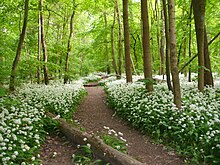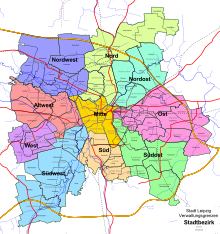
A | B | C | D | E | F | G | H | CH | I | J | K | L | M | N | O | P | Q | R | S | T | U | V | W | X | Y | Z | 0 | 1 | 2 | 3 | 4 | 5 | 6 | 7 | 8 | 9
Leipzig
Leibz'sch (Upper Saxon) | |
|---|---|
|
| |
| Coordinates: 51°20′24″N 12°22′30″E / 51.34000°N 12.37500°E | |
| Country | Germany |
| State | Saxony |
| District | Urban district |
| Government | |
| • Lord mayor (2020–27) | Burkhard Jung[1] (SPD) |
| Area | |
| • City | 297.36 km2 (114.81 sq mi) |
| Population (2022-12-31)[3] | |
| • City | 616,093 |
| • Density | 2,100/km2 (5,400/sq mi) |
| • Metro | 1,001,220 (LUZ)[2] |
| Time zone | UTC+01:00 (CET) |
| • Summer (DST) | UTC+02:00 (CEST) |
| Postal codes | 04001–04357 |
| Dialling codes | 0341 |
| Vehicle registration | L |
| Website | leipzig.de |
Leipzig[a] is the most populous city in the German state of Saxony. The city has a population of 628,718 inhabitants as of 2023.[8] It is the eighth most populous city in Germany. The name of the city and those of many of its districts are of Slavic origin.
Leipzig is located about 150 km (90 mi) southwest of Berlin, in the southernmost part of the North German Plain (the Leipzig Bay), at the confluence of the White Elster and its tributaries Pleiße and Parthe, that form an extensive inland delta in the city known as "Leipziger Gewässerknoten"), along which Leipzig Riverside Forest, Europe's largest intra-city riparian forest has developed. Leipzig is at the centre of Neuseenland (new lake district), consisting of several artificial lakes created from former lignite open-pit mines.
Leipzig has been a trade city since at least the time of the Holy Roman Empire.[9] The city sits at the intersection of the Via Regia and the Via Imperii, two important medieval trade routes. Leipzig's trade fair dates back to 1190. Between 1764 and 1945, the city was a centre of publishing.[10] After the Second World War and during the period of the German Democratic Republic (East Germany) Leipzig remained a major urban centre in East Germany, but its cultural and economic importance declined.[10]
Events in Leipzig in 1989 played a significant role in precipitating the fall of communism in Central and Eastern Europe, mainly through demonstrations starting from St. Nicholas Church. The immediate effects of the reunification of Germany included the collapse of the local economy (which had come to depend on highly polluting heavy industry), severe unemployment, and urban blight. By the early 2000s the trend had reversed, and since then Leipzig has undergone some significant changes, including urban and economic rejuvenation, and modernisation of the transport infrastructure.[11][12]
Leipzig is home to one of the oldest universities in Europe (Leipzig University). It is the main seat of the German National Library (the second is Frankfurt), the seat of the German Music Archive, as well as of the German Federal Administrative Court. Leipzig Zoo is one of the most modern zoos in Europe and as of 2018 ranks first in Germany and second in Europe.[13]
Leipzig's Gründerzeit architecture consists of around 12,500 buildings.[14][15] The city's central railway terminus Leipzig Hauptbahnhof is, at 83,460 square metres (898,400 sq ft), Europe's largest railway station measured by floor area. Since Leipzig City Tunnel came into operation in 2013, it has formed the centrepiece of the S-Bahn Mitteldeutschland (S-Bahn Central Germany) public transit system, Germany's largest S-Bahn network, with a system length of 802 km (498 mi).[16]
Leipzig has long been a major centre for music, including classical and modern dark wave. The Thomanerchor (English: St. Thomas Choir of Leipzig), a boys' choir, was founded in 1212. The Leipzig Gewandhaus Orchestra, established in 1743, is one of the oldest symphony orchestras in the world. Several well-known composers lived and worked in Leipzig, including Johann Sebastian Bach (1723 to 1750) and Felix Mendelssohn (1835 to 1847). The University of Music and Theatre "Felix Mendelssohn Bartholdy" was founded in 1843. The Oper Leipzig, one of the most prominent opera houses in Germany, was founded in 1868. During a stay in Gohlis, which is now part of the city, Friedrich Schiller wrote his poem "Ode to Joy".
Etymology
Name
An older spelling of Leipzig in English is Leipsic. The Latin name Lipsia was also used.[17]
The name Leipzig is ultimately derived from the Slavic designation for basswood (AE) or lime trees (BE) (German: Linden). In the Slavic languages, linden trees are referred to as lipa (Upper and Lower Sorbian, Polish, Slovak, Serbian, Slovene and Croatian: lipa, Czech: lípa). From this root stems the place name Lipsk, which means "settlement where the linden trees stand".[18] The city's name is Lipsk in Upper Sorbian (an official language in eastern Saxony), Lower Sorbian and Polish, and Lipsko in Czech and Slovak.
In 1937 the Nazi government officially renamed the city Reichsmessestadt Leipzig (Reich Trade Fair City Leipzig).[19]
In 1989 Leipzig was dubbed a Hero City, alluding to the honorary title awarded in the former Soviet Union to certain cities that played a key role in the victory of the Allies during the Second World War, in recognition of the role that the Monday demonstrations there played in the fall of the East German regime.[20]
More recently, the city has sometimes been nicknamed the "Boomtown of eastern Germany", "Hypezig" or "The better Berlin" and is celebrated by the media as a hip urban centre for its vibrant lifestyle and creative scene with many startups.[21][22][23][24]
Geography



Location
Leipzig is located in the Leipzig Bay, the southernmost part of the North German Plain, which is the part of the North European Plain in Germany. The city sits on the White Elster, a river that rises in the Czech Republic and flows into the Saale south of Halle. The Pleiße and the Parthe join the White Elster in Leipzig, and the large inland delta-like landscape the three rivers form is called Leipziger Gewässerknoten. The site is characterized by swampy areas such as the Leipzig Riparian Forest (Leipziger Auenwald), though there are also some limestone areas to the north of the city. The landscape is mostly flat, though there is also some evidence of moraine and drumlins.
Although there are some forest parks within the city limits, the area surrounding Leipzig is relatively unforested. During the 20th century, there were several open-pit mines in the region, many of which have been converted to lakes.[25] Also see: Neuseenland
Leipzig is also situated at the intersection of the ancient roads known as the Via Regia (King's highway), which traversed Germany in an east–west direction, and the Via Imperii (Imperial highway), a north–south road.
Leipzig was a walled city in the Middle Ages and the current "ring" road around the historic centre of the city follows the line of the old city walls.
Subdivision
Since 1992 Leipzig has been divided administratively into ten Stadtbezirke (boroughs), which in turn contain a total of 63 Ortsteile (localities). Some of these correspond to outlying villages which have been annexed by Leipzig.

| Stadtbezirk | Pop. (2020)[26] | Area km2[27] | Pop. per km2 |
Ortsteile[28] |
|---|---|---|---|---|
| Mitte | 65,912 | 13.96 | 4,721 | Zentrum, Zentrum-Ost, Zentrum-Südost, Zentrum-Süd, Zentrum-West, Zentrum-Nordwest, Zentrum-Nord |
| Nordost | 48,227 | 26.31 | 1,833 | Schönefeld-Abtnaundorf, Schönefeld-Ost, Mockau-Süd, Mockau-Nord, Thekla, Plaußig-Portitz |
| Ost | 85,519 | 40.73 | 2,100 | Neustadt-Neuschönefeld, Volkmarsdorf, Anger-Crottendorf, Sellerhausen-Stünz, Paunsdorf, Heiterblick, Engelsdorf/Sommerfeld, Althen, Baalsdorf, Kleinpösna/Hirschfeld, Mölkau |
| Südost | 62,506 | 34.72 | 1,800 | Reudnitz-Thonberg, Stötteritz, Probstheida, Meusdorf, Holzhausen, Liebertwolkwitz |
| Süd | 67,079 | 16.95 | 3,957 | Südvorstadt, Connewitz, Marienbrunn, Lößnig, Dölitz-Dösen |
| Südwest | 55,742 | 46.56 | 1,197 | Schleußig, Plagwitz, Kleinzschocher, Großzschocher, Knautkleeberg-Knauthain, Hartmannsdorf-Knautnaundorf |
| West | 54,190 | 14.69 | 3,689 | Schönau, Grünau-Ost, Grünau-Mitte, Grünau-Siedlung, Lausen-Grünau, Grünau-Nord, Miltitz |
| Alt-West | 59,643 | 26.21 | 2,276 | Lindenau, Altlindenau, Neulindenau, Leutzsch, Böhlitz-Ehrenberg, Burghausen, Rückmarsdorf |
| Nordwest | 34,710 | 39.07 | 888 | Möckern, Wahren, Lindenthal, Breitenfeld, Lützschena, Stahmeln |
| Nord | 71,878 | 38.61 | 1,862 | Gohlis-Süd, Gohlis-Mitte, Gohlis-Nord, Eutritzsch, Seehausen, Göbschelwitz, Hohenheida, Gottscheina, Wiederitzsch |











